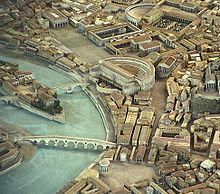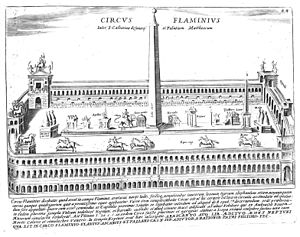Circus Flaminius
41°53′34″N 12°28′39″E / 41.8927578°N 12.4774218°E


The Circus Flaminius was a large, circular area in ancient Rome, located in the southern end of the Campus Martius near the Tiber River.[1] It contained a small race-track used for obscure games, and various other buildings and monuments. It was ‘built,’ or sectioned off, by Gaius Flaminius Nepos in 221 BC.[2]
Topography and structures
In its early existence, the Circus was a loop, approximately 500 meters in length stretching across the Flaminian Fields. During the 2nd century BC, this broad space was encroached upon by buildings and monuments. The circus had no permanent seating, nor were there any permanent structures to mark the perimeter of the race track. By the early 3rd century AD, the only open space that remained was a small piazza in the center, no more than 300 meters long, where the ludi (public games) had always been held.
There were many structures in the vicinity of the circus (“in circo Flaminio”). The Temple of Pietas lay on the edge of the Forum Holitorium to the southeast. The Temple of Mars was situated in the northwest. It is estimated that by 220 BC there were six temples, including one to Apollo, in the Flaminian Fields. In AD 15, statues to the deified Augustus were erected, dedicated by C. Norbanus Flaccus. Also inside was the Porticus Octaviae. The entrance to the piazza was marked by one of three large marble arches erected in honor of Germanicus, engraved with records of his military conquests. To the east was the Theatre of Marcellus.
A fragment of the Severan marble plan preserves a mention of the Circus Flaminius.
Use
The Circus Flaminius was never meant to rival the much larger Circus Maximus, and, unlike the Circus Maximus, it was not just an entertainment venue. It almost certainly lacked a track designed for chariot racing.[3] The only ludi held there were the Taurian Games, which featured horseback racing around turning posts (metae).[4] The obscure Taurian Games were held to propitiate the gods of the underworld (di inferi), and seem to have been symbolically grounded in the site itself, as they were never moved to a different circus. Equestrian events were also associated with underworld deities in other rituals and festivals in the Campus Martius. Strabo makes no mention of equestrian activities taking place in the Circus Flaminius. Valerius Maximus, who is likely to be in error, is the only ancient source that claims the Ludi Plebeii (Plebeian Games) were held there. In 2 BC, the circus was flooded for the slaughter of 36 crocodiles to commemorate the building of the Forum of Augustus.[5]
The Circus Flaminius was also used as a market. Assemblies were often held within it. In AD 9, it was the venue when Augustus delivered the Laudatio of Drusus.
The buildings remained in use until the end of the fourth century, when the area was finally abandoned.
Notes
- ^ Pier Luigi Tucci, 'Nuove ricerche sulla topografia dell’area del circo Flaminio’, Studi Romani 41 (1993) 229-242
- ^ John H. Humphrey (1 January 1986). Roman Circuses: Arenas for Chariot Racing. University of California Press. pp. 543–. ISBN 978-0-520-04921-5.
- ^ T.P. Wiseman, Remus: A Roman Myth (Cambridge University Press, 1995), p. 211
- ^ Varro, De lingua latina 5.154; also recorded by the Fasti Ostienses.
- ^ Cassius Dio Roman History 55.10
Sources
Platner, Samuel (1929). A Topographical Dictionary of Ancient Rome. Oxford University Press.
Civilization of the ancient Mediterranean: Greece and Rome. Vol. II. Scribner's. 1998.
Humphrey, John (1986). Roman Circuses: Arenas for Chariot Racing. Butler & Tanner Ltd. pp. 540–545. ISBN 0-520-04921-7.
